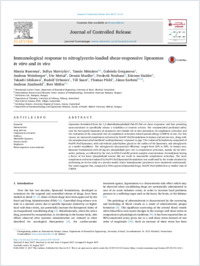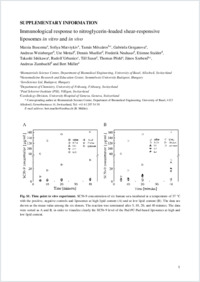Immunological response to nitroglycerin-loaded shear-responsive liposomes in vitro and in vivo
- Buscema, Marzia Biomaterials Science Center, Department of Biomedical Engineering, University of Basel, Switzerland
- Matviykiv, Sofiya Biomaterials Science Center, Department of Biomedical Engineering, University of Basel, Switzerland
- Mészáros, Tamás Nanomedicine Research and Education Center, Institute of Pathophysiology, Semmelweis University Budapest, Hungary - SeroScience Ltd., Budapest, Hungary
- Gerganova, Gabriela Biomaterials Science Center, Department of Biomedical Engineering, University of Basel, Switzerland
- Weinberger, Andreas Department of Chemistry, University of Fribourg, Switzerland
- Mettal, Ute Department of Chemistry, University of Fribourg, Switzerland
- Mueller, Dennis Department of Chemistry, University of Fribourg, Switzerland
- Neuhaus, Frederik Department of Chemistry, University of Fribourg, Switzerland
- Stalder, Etienne Department of Chemistry, University of Fribourg, Switzerland
- Ishikawa, Takashi Paul Scherrer Institute (PSI), Villigen, Switzerland
- Urbanics, Rudolf SeroScience Ltd., Budapest, Hungary
- Saxer, Till Cardiology Division, University Hospital of Geneva, Switzerland
- Pfohl, Thomas Biomaterials Science Center, Department of Biomedical Engineering, University of Basel, Switzerland
- Szebeni, János Nanomedicine Research and Education Center, Institute of Pathophysiology, Semmelweis University Budapest, Hungary - SeroScience Ltd., Budapest, Hungary - Department of Nanobiotechnology and Regenerative Medicine, Faculty of Health, Miskolc University, Hungary
- Zumbuehl, Andreas Department of Chemistry, University of Fribourg, Switzerland
- Müller, Bert Biomaterials Science Center, Department of Biomedical Engineering, University of Basel, Switzerland
-
28.10.2017
Published in:
- Journal of Controlled Release. - 2017, vol. 264, no. Supplement C, p. 14–23
English
Liposomes formulated from the 1,3-diamidophospholipid Pad-PC-Pad are shear- responsive and thus promising nano-containers to specifically release a vasodilator at stenotic arteries. The recommended preclinical safety tests for therapeutic liposomes of nanometer size include the in vitro assessment of complement activation and the evaluation of the associated risk of complement activation-related pseudo-allergy (CARPA) in vivo. For this reason, we measured complement activation by Pad-PC- Pad formulations in human and porcine sera, along with the nanopharmaceutical- mediated cardiopulmonary responses in pigs. The evaluated formulations comprised of Pad-PC-Pad liposomes, with and without polyethylene glycol on the surface of the liposomes, and nitroglycerin as a model vasodilator. The nitroglycerin incorporation efficiency ranged from 25% to 50%. In human sera, liposome formulations with 20 mg/mL phospholipid gave rise to complement activation, mainly via the alternative pathway, as reflected by the rises in SC5b-9 and Bb protein complex concentrations. Formulations having a factor of ten lower phospholipid content did not result in measurable complement activation. The weak complement activation induced by Pad- PC-Pad liposomal formulations was confirmed by the results obtained by performing an in vivo study in a porcine model, where hemodynamic parameters were monitored continuously. Our study suggests that, compared to FDA-approved liposomal drugs, Pad-PC-Pad exhibits less or similar risks of CARPA.
- Faculty
- Faculté des sciences et de médecine
- Department
- Département de Chimie
- Language
-
- English
- Classification
- Chemistry
- License
-
License undefined
- Identifiers
-
- RERO DOC 305664
- DOI 10.1016/j.jconrel.2017.08.010
- Persistent URL
- https://folia.unifr.ch/unifr/documents/305966
Other files
Statistics
Document views: 97
File downloads:
- pdf: 195
- Supplementary material: 141

